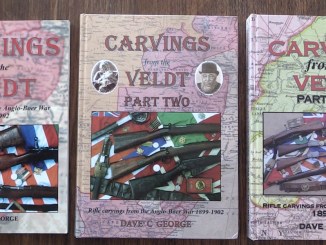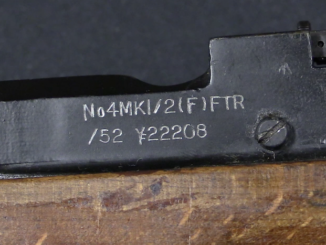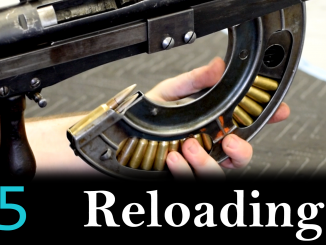Nope, it’s not mine (although I do look forward to visiting the NFC again in the future) – my friend Vic has started a video channel looking at some of the guns in the monumental National Firearms Centre (aka, the Pattern Room) collection. for his first video (with a low-quality backup camera, due to some equipment problems) he and NFC Curator Jonathan Ferguson discuss the early British selfloaders – the EM-1, EM-2, and .280 caliber FAL. I am looking forward to seeing this channel continue and grow!
Related Articles

Book review
Book Review: Carvings From the Veldt (3 Volumes)
Over the past 15 year, Dave C. George has compiled three volumes of his book “Carvings From the Veldt”, documenting nearly a thousand carved rifles from the Boer War. This is feature almost unique to […]

Bolt Action Rifles
No4 MkII: The Lee Enfield’s Final Standard Upgrade
The final standard pattern of the venerable Lee Enfield as a standard-issue service rifle was the No4 MkII, introduced after the end of World War Two. The new pattern was adopted to resolve problems that […]

Light MGs
Project Lightening Episode 05: Reload
Project Lightening is a collaborative series with Othais and Mae of C&Rsenal in which we test all seven light machine guns and automatic rifles of World War One and put them through a series of […]

It’s interesting what Mr. Ferguson says about parts interchangeability at about the 3:30 mark. He even refers to it as “Sam Colt’s idea.” This was the so-called “American system of manufacture” (and I’ve even read that the Royal Small Arms Factory hired an American to oversee their plant when they began to implement it with the production of the 1853 pattern Enfield rifle musket). Mr. Ferguson mentions that it wasn’t until as late as WWII that you really got all weapons with fully interchangeable parts. This echoes something I saw in a “Tank Overhaul” episode, where a group of collectors and restorers in the UK were restoring an M4 Sherman. One of the restorers mentioned that one of the benefits of working on American equipment like the Sherman was that when a part needed replacing, you could just take the replacement part off the shelf and drop it right into place, whereas with British equipment, he said, it generally “needs a bit of fiddlin'” (meaning skilled fitting) to make it go in. I do wonder why the Brits took so bloody long to get real production engineering and parts interchangeability nailed down.
“M4 Sherman”
From first hand information from M4 GENERAL SHERMAN user see:
http://iremember.ru/en/memoirs/tankers/dmitriy-loza/
It strongly suggests that the costs of setting the system up, were expected to outweigh the later benefits once they were discounted at the market interest rate.
What were those dis-advantages?
The difference between the money advanced to the workers for parts and the final selling price of the completed gun – is the interest
the money is being advanced before it would have been if the workers had chosen to complete the gun themselves and wait for the sale – which is something that they could have chosen to do, but didn’t.
Most of the British industry was based on the “Mester” system until quite recently. Centers like Birmingham and Sheffield excelled in this process, as well as London’s best gunsmiths. Basically the company owner would provide raw materials, and collect and sell the finished goods. In the case of guns this was either castings or forgings which went out to small artisans to complete, often in several stages, with money changing hands at each stage. Areas within the cities became know for specific tasks such as gun barrel manufacturing in Oldbury Birmingham, while spring sand locks were made in Willenhall, also in Birmingham etc. (incidentally the Willeese had a superstition that any spring tempered on a Wednesday afternoon would break, so they took the afternoon off. This gave rise to the Wednesday Soccer leagues) The shadows of this area specialty is still to be seen to this day. Yale and other lock makers settled in Willenhall, and Oldbury still makes high quality tubes, some of which still go into gun barrel manufacture. The jewelry quarter in Birmingham, still works this way today. What the system lacked in standardization it made up for in material efficiency, and unlike USA, we had plenty of people. Advantages to the company owners were many, as were the disadvantages to the artisans forced to work under it
This is very much how FN of Herstal had originated. Although officially based on adoption of Mauser rifle model 1889, the network of specialised artisans existed in and around Liege for centuries.
Wonderful video, Ian! Your series keeps getting better and better……….. 😉
i watch all your and carl,s video,s F.W F.R but this one wow i must wave the flag from the uk.2 british IAN,s..
Outstanding video from across the pond. Looking forwards to more. The book “Rapid Fire” from 2000 or so was written largely on research at the original Pattern Room.
The .280 British was a great design and even today, our 6.8 mm SPC round is almost an exact copy of the performance that our Military rejected in favor of the 7.62×51 Nato round. I guess we need to re-invent the wheel over and over again until we finally get it correct
Later 6x45mm SAW was developed:
http://www.municion.org/6Mm/6x45Saw.htm
which also was between 5.56×45 and 7.62×51, but it was not adopted.
Russians also developed 6mm cartridge – 6x49mm – in late 1980s:
http://topwar.ru/19957-patron-6h49-i-snayperskie-vintovki-svk-svk-s-tkb-0145k.html
It fire 5g bullet @ 1150m/s, special groove above extractor groove allow usage of higher pressure without problems of sticky extraction (that lower service life of automatic weapons), this is idea of В.М. Кириллов from 1960s. Following weapons use this cartridge: СВК sniper rifle, СВК-С sniper rifle, avtomat derived from АН-94 “Абакан”, machine gun derived from ПКМ and ТКБ-0145К sniper rifle (created in 2001).
http://sniper-weapon.ru/boepripasy/370-patron-6kh49-mm
That was enlightening discussion between those two gentlemen. For one thing, it was first time when was explained to me the term “pattern room”. In fact it is what it is expected to be: National firearm museum.
When they talked about FAL conversion to inch system I can add that it is true Canada had a conversion done to this purpose and special body overseeing ‘development’ (rifle steering committee) was established for that purpose. Utterly impractical and wasteful, but it did happen. To some people millimeters were complete mystery.
Maybe the term “utterly impractical” (in sense of units conversion) is just partially true because the team of engineers at long Brach Armory in Toronto also developed in parallel a new specifically Canadian version – the C2 heavy support rifle.
This was selective fire weapon with heavy barrel and bipod. However, the action was still rifle type (closed bolt) and barrel was not quick interchangeable.
Regarding EM-1 and EM-2 developments, there are books I can recommend.
One is with title “EM-2 Concept and Design” by Thomas B. Dugelby (collectors Grade Publications, Toronto, Canada) and “Modern Military Bulpup Rifles” by same author.
I happen to own the second one. It part of various other designs also covers EM version in other calibers such as 6.25 x 43 and 4.85 x 49. There is wealth of data, which one would not expect in such a thin book.
Thanks for the link to this site, as a Brit it is grand to have the resource.
Content is good and I look forward to learning more about their wonderful collection….if Ian could come over and lend his presentation style it would be perfect ;0)
I can’t fault the content, but can we hope for a higher-resolution image in future episodes? Pretty please.
Guys, thanks for the kind words about the first video I produced. The quality will get better as I have new camera equipment now and not the ‘loaned’ equipment I had during the first visit to the NFC.
Hopefully my presentation style will grow on you after a while, unfortunately my hair and beard will never match or rival Ian’s 😉